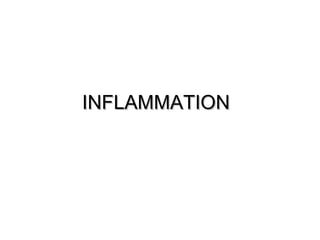
Acute inflammation optimetery lect 2
- 1. INFLAMMATION
- 2. Injury Acute inflammation Abscess Chronic inflammation Resolution Repair
- 3. “Inflame” – to set fire. Inflammation is “A dynamic response of vascularised tissue to injury.” It is a protective response. It serves to bring defense & healing mechanisms to the site of injury.
- 4. What is Inflammation? A reaction of a living tissue & its micro-circulation to a pathogenic insult. A defense mechanism for survival .
- 5. Reaction of tissues to injury, characterized clinically by: heat, swelling, redness, pain, and loss of function. Pathologically by : vasoconstriction followed by vasodilatation, stasis, hyperemia, accumulation of leukocytes, exudation of fluid, and deposition of fibrin.
- 6. How Does It Occur? • The vascular & cellular responses of inflammation are mediated by chemical factors (derived from blood plasma or some cells) & triggered by inflammatory stimulus. • Tissue injury or death ---> Release mediators
- 7. Etiologies • Microbial infections: bacterial, viral, fungal, etc. • Physical agents: burns, trauma--like cuts, radiation • Chemicals: drugs, toxins, or caustic substances like battery acid. • Immunologic reactions: rheumatoid arthritis.
- 8. Cardinal Signs of Inflammation Redness : Hyperaemia. Warm : Hyperaemia. Pain : Nerve, Chemical mediators. Swelling : Exudation Loss of Function: Pain
- 10. Time course Acute inflammation: Less than 48 hours Chronic inflammation: Greater than 48 hours (weeks, months, years) Cell type Acute inflammation: Neutrophils Chronic inflammation: Mononuclear cells (Macrophages, Lymphocytes, Plasma cells).
- 11. Pathogenesis: Three main processes occur at the site of inflammation, due to the release of chemical mediators : Increased blood flow (redness and warmth). Increased vascular permeability (swelling, pain & loss of function). Leukocytic Infiltration.
- 12. Mechanism of Inflammation 1. Vaso dilatation 2. Exudation - Edema 3. Emigration of cells 4. Chemotaxis
- 13. The major local manifestations of acute inflammation, compared to normal. (1) Vascular dilation and increased blood flow (causing erythema and warmth). (2) Extravasation and deposition of plasma fluid and proteins (edema). (3) leukocyte emigration and accumulation in the site of injury.
- 14. Changes in vascular flow (hemodynamic ) changes Slowing of the circulation outpouring of albumin rich fluid into the extravascular tissues results in the concentration of RBCs in small vessels and increased viscosity of blood. Leukocyte margination Neutrophi become oriented at the periphery of vessels and start to stick.
- 15. Time scale Variable minor damage---- 15-30 minutes severe damage---- a few minutes
- 16. :Lymphatics in inflammation Lymphatics are responsible for draining edema. Edema: An excess of fluid in the interstitial tissue or serous cavities; either a transudate or an exudate
- 17. Transudate: • An ultrafiltrate of blood plasma – permeability of endothelium is usually normal. – low protein content ( mostly albumin)
- 18. Exudate: • A filtrate of blood plasma mixed with inflammatory cells and cellular debris. – permeability of endothelium is usually altered – high protein content.
- 19. Pus: • A purulent exudate: an inflammatory exudate rich in leukocytes (mostly neutrophils) and parenchymal cell debris.
- 20. Leukocyte exudation Divided into 4 steps Margination, rolling, and adhesion to endothelium Diapedesis (trans-migration across the endothelium) Migration toward a chemotactic stimuli from the source of tissue injury. Phagocytosis
- 23. Phagocytosis 3 distinct steps Recognition and attachment Engulfment Killing or degradation
- 25. Defects in leukocyte function: • Margination and adhesion – steroids, leukocyte adhesion deficiency • Emigration toward a chemotactic stimulus • drugs • chemotaxis inhibitors • Phagocytosis • Chronic granulomatous disease (CGD)
- 26. Inflammation Outcome Fibrosis/Scar Resolution Acute Chronic Injury Inflammation Inflammation Abscess Fungus Virus Cancers Ulcer .T.B. etc Fistula Sinus
- 27. :Chemical Mediators Chemical substances synthesised or released and mediate the changes in inflammation. Histamine by mast cells - vasodilatation. Prostaglandins – Cause pain & fever. Bradykinin - Causes pain.
- 28. Morphologic types of acute inflammation Exudative or catarrhal Inflammation: excess fluid. TB lung. Fibrinous – pneumonia – fibrin Membranous (fibrino-necrotic) inflammation Suppuration/Purulent – Bacterial - neutrophils
- 29. Serous – excess clear fluid – Heart, lung Allergic inflammation Haemorrhagic – b.v. damage - anthrax. Necrotising inflammation.
- 30. Acute inflammation has one of four outcomes: • Abscess formation • Progression to chronic inflammation • Resolution--tissue goes back to normal • Repair--healing by scarring or fibrosis
- 31. Abscess formation: • "A localized collection of pus (suppurative inflammation) appearing in an acute or chronic infection, and associated with tissue destruction, and swelling.
- 32. • Site: skin, subcutaneous tissue, internal organs like brain, lung, liver, kidney,……. • Pathogenesis: the necrotic tissue is surrounded by pyogenic membrane, which is formed by fibrin and help in localize the infection.
- 33. Carbuncle - It is an extensive form of abscess in which pus is present in multiple loci open at the surface by sinuses. - Occur in the back of the neck and the scalp.
- 34. Furuncle or boil - It is a small abscess related to hair follicles or sebaceous glands, could be multiple furunclosis.
- 35. Cellulitis - It is an acute diffuse suppurative inflammation caused by streptococci, which secrete hyaluronidase & streptokinase enzymes that dissolve the ground substances and facilitate the spread of infection.
